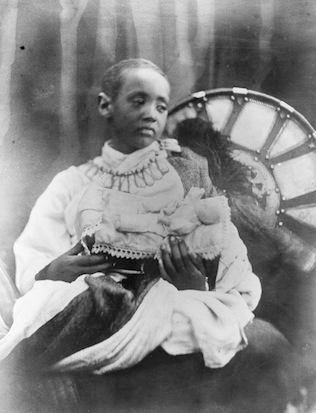An extraordinary black-and-white photograph of a young black boy taken on the Isle of Wight by Julia Margaret Cameron in 1868 shows him in exotic clothes and a heavy silver-bead necklace, like a chain-of-office or a prisoner’s collar. He looks so sad, reminding me of the caged lions in London Zoo, his eyes heavy-laden, his listless body lacking the restless energy you would expect of a seven-year-old. He is Prince Alemayehu of Ethiopia, brought to England after his father, the emperor, committed suicide in his palace at Addis Ababa having just been defeated by the British. His story featured on Lemn Sissay’s Homecoming (Radio 4), broadcast in the ‘comedy slot’ on Tuesday evening — a sure way for this poignant, mind-stretching half-hour to stand out in stark contrast to the often pointlessly unfunny shows that usually fill this slot.
Sissay, who uses language as a political weapon, brilliantly swishing it this way and that to effect his meaning, was on a quest to find out what home means. He was born in England, of an Ethiopian mother, but given away immediately to be fostered. His foster parents dumped him, aged 12, in a children’s home and refused to have anything more to do with him. At 18 he was given his birth certificate (a legal requirement) and began ‘in that moment’ his search for ‘home’.
Sissay wonders whether he can ever belong in Addis Ababa given that he doesn’t speak Amharic and has never lived there. He asks his audience at a comedy gig in the Ethiopian capital, ‘Is this my home?’ He tells them Alemayehu’s story and how the prince died aged 18, of pleurisy, and was buried in St George’s Chapel, Windsor; or rather there’s a memorial plaque to him in the chapel with the biblical text ‘I was a stranger and ye took me in’ blazoned across it. In fact, Alemayehu’s remains were buried outside the chapel and the Ethiopian government now wants them back, a request that has so far been refused. As Sissay says, ‘We have just dug up King Richard III and you’ve never heard such a fuss about where he should be buried. And that skeleton is 500 years old…’ A huge indrawn breath from his audience.
Sissay also talked to the grandson of Sylvia Pankhurst, who was born and brought up in Addis Ababa (Pankhurst was a great fan of Ethiopia and is buried there), a white man in Africa. ‘I like English ways — I like punning,’ Pankhurst tells Sissay. ‘But at the same time I feel perfectly at ease, comfortable and fluent in Ethiopia too.’
This was truly innovative radio (produced by Ed Morrish), fusing Sissay’s comedy act as a performance poet with conversations and multiple storytelling, underpinned by music to take us out of England and straight to Addis. Later that evening on Radio 4 was a much-heralded audio première, the outcome of a collaboration between the BBC and Artangel, an organisation that funds artists and their work. The Quarryman’s Daughters by Katrina Palmer was described as ‘an audio artwork’, telling the story of two sisters who live in simple huts on either side of the isle of Portland in Dorset. One hut looks out to sea, the other turns inward. One sister stays where she is, brooding on the elemental history of this outpost of Britain, stuck on to the coast by a thin finger of land, and source for centuries of the building blocks of many landmark buildings — St Paul’s Cathedral, the British Museum, Broadcasting House. The other meets a trio of ‘loss adjusters’, with whom she has a weird sexual relationship before coming to a sticky end, felled by a stone probably quarried by her grandfather.
This strange tale (filled with naughty words and graphic sex, which explains why it had to be aired so late at night) was tagged on to what began as a piece of audio archaeology, drilling through the layers of Portland’s history. The casts and moulds of living creatures that lived in the mud of the Jurassic period, 147 million years ago, can still be seen embedded in the rocks quarried from the island. Take a look at the new stonework next time you pass by Green Park underground station. ‘These stones have absorbed an enormous quantity of death…’
He lost a pawn after just three moves and was routed within 15. Piers Morgan, ex-newspaper editor and American TV chatshow host, was playing chess with Dominic Lawson (who was at prep school with him) in Across the Board (produced by David Edmonds). Five minutes earlier he cheekily told Lawson that he was in trouble (on the board), even if he didn’t realise it.
Lawson (our former editor and a chess champion) uses the game to try and tease out truths about his opponents. It’s a slightly bonkers idea, yet it works, Morgan coming over far more sympathetically than if we had seen him on the box, with that perma-tanned look and knowing smile. In fact, dare I say it, I almost wanted him to win.






Comments